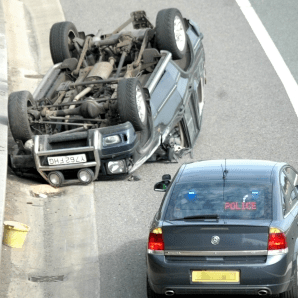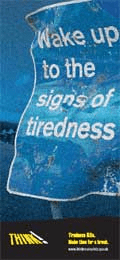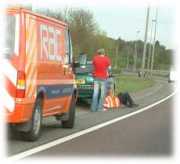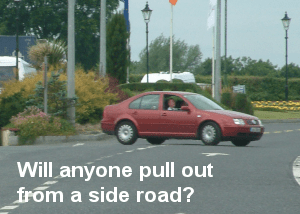More helpful hints and tips for after you have finished your Driving Lessons in Newcastle.
Motorway madness 
MotorwayBritain’s first motorway, the Preston Bypass, was opened on December 5th 1958 by the then Prime Minister, Harold Macmillan; four hours after the opening ceremony, Harold Bradshaw earned a place in UK motoring history when he became the first recorded motorway casualty after falling from a bridge above the road.
Hot on the heels of the Preston Bypass came the M1, the first 72 miles of which were opened on April 11th 1960 bridging the great North/South divide and providing a test track for high-performance sports cars!
Despite the fact that the motorway network is now several thousand miles longer than it was when I had my first motorway adventure back in the early 1970’s, there is still no requirement for compulsory motorway tuition or testing. Anyone who has passed the practical driving test can jump into a car and dive headlong into an experience similar to my own!
What has changed, however, is that although learner drivers are not permitted on motorways, the Theory-Test (compulsory for all new drivers) requires candidates to answer questions about motorway driving. This leads me to wonder how many learner drivers know more about motorway rules and regulations than the full licence holders who have been driving on motorways for years!
Whether or not motorway training becomes a compulsory requirement, there might well come a time when it will no longer be an issue. One idea that has been researched, and for which the technology already exists, is that of linking cars together on motorways. Using on-board computers coupled with speed/distance sensors, it is possible to form a motorway train. After ‘logging on’ to the train, you could read a newspaper, fall asleep or simply sit back and enjoy the ride. For now though, sleeping safely on the motorway remains a distant dream.
So how safe are you?
Although statistics suggest that motorways are our safest roads, they do pose significant risks, especially for those who don’t regularly drive at higher speeds. Statistics also tell us that driver error is present in 90% of motorway accidents (with mechanical failure accounting for only 10%). So how safe are you now and what can you do to maximise your future safety on the motorway?
Accident 
Most motorway accidents are caused by one, or a combination of the following:
Following too closely
Weather
Tiredness and lack of concentration
Problems associated with breakdowns
Too close for comfort…
Over the years, many individuals and organisations (Including the Institute of Advanced motorists and some Chief Police Constables) have called for increases in motorway speed limits; however, others think that this would be a recipe for more accidents. Although higher speeds will inevitably increase the severity of accidents, speed in itself is not usually the cause of motorway accidents.
Whatever your views on speed limits, driving more slowly will not necessarily reduce your risk of an accident on the motorway. The real problem lies in the way that drivers use speed on motorways. Consider the following figures:
At 70 mph covers about 35 metres per second (try walking 35 metres with your eyes shut to appreciate this distance!)
From the moment that the brakes are applied it will take somewhere in the region of 75 metres to stop (assuming a well maintained vehicle and a good, dry road!)
Most drivers have a reaction time of over half a second (this is before they touch the brakes)
Tired, ill or distracted drivers can take well over a second to react to danger
Given the information above, it doesn’t take a mathematical genius to work out that drivers who only leave a separation gap of three or four car lengths when travelling at 70 mph will not have a chance of stopping if faced with a sudden emergency.
By keeping a one-metre gap for each mile per hour of your speed, or applying the ‘two-second rule’ you will do a lot to reduce your risk. Another major benefit of maintaining a safe distance is that it will give you plenty of time and space for safe, well planned lane changes – it’s estimated that up to 25% of motorway accidents are caused by reckless or late lane change manoeuvres.
The British climate…
The problem with vehicle separation becomes even worse in poor weather conditions. On a wet road your stopping distance will often double, but that’s only part of the problem. In order to achieve this stopping distance, your wheels need to be in contact with the road surface.
Because of the width of motorway carriageways it is not possible to achieve the same degree of camber that is found on narrower roads; this means that in a heavy rainstorm, water will not drain as quickly and there is a possibility of standing water – this can cause your front wheels to lose their grip on the road surface (aquaplaning). Stay safe in the wet by reducing your speed, doubling your separation distance and turning off cruise control.
One of the biggest motorway killers is fog, or rather the way that some drivers behave in foggy conditions. It never ceases to amaze me that despite at least one major fog smash making the headlines every year, drivers still hurtle along foggy motorways as if it were a bright summers day! My best advice about driving in motorway fog is “Don’t”.
Stay alert!
As cars become more sophisticated, the potential for driver distraction is perhaps greater than ever before. Mobile phones, global positioning systems, route finders, sophisticated in-car entertainment, etc., all require the driver’s attention; however, tiredness remains one of the most dangerous blocks to motorway concentration.
Tiredness kills 
Many of our motorways now have signs reminding us that: ‘Tiredness kills – Take a break’. The causes of sleepiness vary from driver to driver but no one is immune. It could be the heavy meal and couple of drinks you had earlier, or medication from a doctor or pharmacy (many over-the-counter medicines cause drowsiness). Long straight stretches of motorway result in some drivers succumbing to the hypnotic effect of the white lines flashing by, especially if they are bored or tired.
If you feel drowsy, pull off the motorway at the next exit or service area for a break. A caffeinated drink and a twenty-minute catnap will help to keep you to recover.
Beware!
If you do pull in for a break don’t make the same mistake as the German tourist who was stopped by the Wiltshire Police after driving for 30 miles without realising that he had left his wife behind at the service station. (Nice try!)
Hard Luck!
Sometimes, because of breakdowns or other emergencies, drivers are forced to park on the motorway. It’s very important to keep your wits about you in this situation and (unlike the man who was found trying to change a wheel in the outside lane of the M1) get off the main carriageway to a place of safety – namely, the hard shoulder. This is one of the first rules taught in driving instructor training about motorway lessons.
Hard Shoulder 
Although I refer to the hard shoulder as a place of safety, it is actually one of the riskiest places on the motorway. If you are forced to stop on the hard shoulder, switch on your hazard lights, inform the authorities immediately and stay well clear of your vehicle while waiting for help.
Even if you can fix the problem yourself, for example changing a wheel, you will be a lot safer if there is a conspicuous police or breakdown patrol vehicle providing a protective shield behind your car.
So … Remember the basic survival rules for driving on the motorway:
Keep your distance
Check your speed in poor weather conditions
Stay alert at all times











